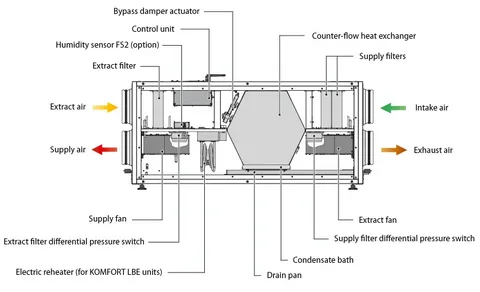Are you looking to improve your home’s energy efficiency while enhancing indoor air quality? Consider installing a heat exchange unit in your home. A heat exchange unit, also known as an HRV (Heat Recovery Ventilator) or ERV (Energy Recovery Ventilator), can benefit your home and your family. This blog post will discuss the advantages of installing a hrv unit and how it can improve your living environment. One of the key benefits of a heat exchange unit is its ability to maintain a comfortable temperature while minimizing energy loss. Additionally, it can significantly reduce humidity levels and help filter out pollutants, ensuring a healthier atmosphere inside your home.
Understanding How Heat Recovery Units Operate
A remarkably efficient process known as heat recovery is at the core of a heat exchange unit’s functionality. This system ingeniously capitalizes on the energy already used within your home to minimize waste and optimize temperature control. Here’s a closer look at how it works: during colder months, the unit captures heat from outgoing indoor air—the air you’ve already heated—and transfers it to the cooler air being drawn into the house.
This transfer warms up the incoming air before circulating through your living spaces, reducing the demand for your heating system. Conversely, in warmer seasons, the unit inverts its operation. It extracts heat from the incoming air, which has been heated by the external environment and transfers this heat to the outgoing air, thus cooling the air that enters your living spaces.
This dual capability conserves the energy used for heating and cooling. It ensures that the air inside your home is continually refreshed without the significant energy loss typically associated with traditional ventilation methods. Heat exchange units provide a sustainable solution for maintaining comfortable indoor environments by leveraging the temperature differential between indoor and outdoor air. This smart technology enables homeowners to achieve balanced ventilation and temperature control, showcasing the seamless integration of comfort and energy efficiency.
Enhancing Energy Efficiency and Reducing Utility Bills
One of the standout advantages of integrating a heat exchange unit into your home is the potential for substantial energy savings. These systems are engineered to utilize the heat from outgoing air to warm up the cooler incoming air during colder seasons and vice versa when the temperatures rise. This ingenious process means your heating and cooling systems can work less hard to maintain comfortable indoor temperatures.
As a result, you can see a noticeable reduction in your energy consumption, which directly translates to lower utility bills. Research and real-world applications have demonstrated that homeowners can experience up to 30% savings on their heating and cooling expenses with the addition of a heat exchange unit.
This efficiency level is achieved without sacrificing comfort, making it a smart choice for those looking to reduce their energy footprint and keep household costs in check. By leveraging the existing air temperature differences, these units ensure that you’re saving money and contributing to a more sustainable and efficient use of resources in your home.
Improving Indoor Air Quality with Hrv Heat Recovery
An often overlooked aspect of a home’s health and comfort is its indoor air quality. HRV heat recovery systems are pivotal in elevating this quality by constantly exchanging stale, contaminated indoor air with fresh, clean outdoor air. This process is crucial for homes prone to pollutants or allergens. As the HRV system expels indoor air, it simultaneously draws in outdoor air, but only by first passing it through filtration. This filtration ensures that the incoming air is fresh and free from common outdoor pollutants like pollen, dust, and vehicle emissions.
Moreover, HRV heat recovery systems maintain optimal humidity levels inside the home. They effectively reduce excess moisture, which can lead to mold growth and exacerbate respiratory conditions. By controlling humidity, these systems prevent the air from becoming too dry in the winter or overly humid in the summer, conditions that can negatively affect comfort and health.
The continuous renewal of air also dilutes and removes indoor pollutants such as volatile organic compounds (VOCs) emitted from paints, furnishings, and cleaning products. In households where the air tends to remain stagnant, the concentration of these pollutants can reach levels many times higher than outdoor air, posing significant health risks over time. An HRV heat recovery system ensures these pollutants are regularly flushed out and replaced by cleaner air, creating a healthier living environment.
Prolonging the Lifespan of Your Hrv Heating System
Integrating a heat exchange unit into your home optimizes energy consumption and indoor air quality and significantly contributes to the longevity of your hrv heating system. Thanks to the efficient transfer of heat between incoming and outgoing air, your heating and cooling systems experience less strain over time. This diminished workload can lead to fewer mechanical failures, a decreased need for urgent repairs, and an extension of the overall service life of your HVAC equipment.
The principle behind this is straightforward yet impactful. By pre-warming or pre-cooling incoming air, the heat exchange unit ensures that your HVAC system isn’t overburdened with extreme temperature variations that demand high energy use and cause rapid wear and tear. This steadier operational demand helps maintain the system’s efficiency. It prevents the common pitfalls of overuse, such as overheating in the summer or overworking in the winter to combat the cold.
Moreover, this approach contributes to a balanced system operation, allowing for more predictable maintenance schedules and lowering the frequency of service calls. It’s a proactive measure that not only enhances the performance of your HVAC system but also safeguards it against the premature aging that often results from constant high-intensity use. In essence, by adopting a heat exchange unit, you’re investing in immediate comfort and efficiency benefits and the long-term resilience and reliability of your home’s heating system.
Enhancing Home Comfort Throughout the Year
A heat exchange unit significantly contributes to creating a consistently comfortable atmosphere within your home, eliminating the fluctuations that can lead to discomfort during extreme weather conditions. By adeptly managing heat transfer in and out of your home, these units ensure that the air inside is neither too hot in the summer nor too cold in the winter. This regulation helps avoid the discomfort of sudden temperature changes, promoting a stable and pleasant indoor environment all year round.
The unique ability of heat exchange units to pre-condition incoming air means the indoor environment is more controlled. This leads to reduced drafts, often a source of discomfort in homes without such systems. In warmer months, the cooling effect provided by transferring heat out of the incoming air reduces the reliance on air conditioning units, which can create zones of differing temperatures within the home. In colder seasons, the warmth transferred from outgoing air to incoming air reduces the need for excessive heating, often leading to overly dry air and discomfort.
Moreover, by maintaining a more constant temperature, these units help prevent the structural damage to your home that can come from the continuous expansion and contraction associated with wide temperature swings. This contributes to your comfort and the durability and integrity of your home.
Choosing the Right Hrv Heat Exchanger for Your Home
Selecting the ideal HRV heat exchanger for your residence involves considering several crucial factors to ensure optimal performance and efficiency. Here are four key aspects to guide you in making an informed decision:
Size and Capacity
The size of the heat exchange unit should be directly proportional to the square footage of your home and its specific ventilation needs. A unit that is too small won’t effectively manage the air volume, leading to inadequate ventilation and energy inefficiency. Conversely, an overly large system can result in unnecessary energy consumption and increased costs. Consulting with a professional can help determine the appropriate size for your space.
Energy Efficiency Ratings
Look for units with high energy efficiency ratings. The efficiency of an HRV heat exchanger is often indicated by its heat recovery efficiency—the percentage of heat that can be recovered from the outgoing air. Higher ratings signify more effective heat recovery, which can significantly impact your energy savings and reduce your environmental footprint.
Features and Controls
Advanced features such as programmable timers, multiple speed settings, and built-in humidity sensors can enhance the functionality and flexibility of your HRV system. These controls allow for more precise management of air quality and comfort levels, adapting to your family’s daily routines and seasonal changes.
Installation and Maintenance Requirements
Consider the ease of installation and the system’s maintenance needs. Some heat exchange units may require professional installation and regular maintenance to ensure they operate at peak efficiency. Review the manufacturer’s instructions and consult with specialists to understand the ongoing care and potential costs associated with your chosen unit.
Maintaining Your Air Recovery Unit for Long-Term Efficiency
Regular Filter Replacement
To ensure the efficiency of your air recovery unit, it’s essential to replace the filters regularly. Clogged filters can restrict airflow, forcing the unit to work harder and use more energy. Typically, filters should be checked every three months and replaced as needed to maintain optimal air quality and unit performance.
Annual Inspections
Scheduling a yearly inspection with a qualified technician can help identify and rectify any potential issues before they become major problems. This preventative measure ensures your system operates efficiently, prolongs its lifespan, and prevents unexpected breakdowns that could affect your home’s comfort levels.
Clean Air Intakes and Exits
Keeping the air intakes and exits free from obstructions is crucial for maintaining airflow efficiency. Periodically check these areas for debris, such as leaves or snow, that could block air from moving freely in and out of the unit.
Monitor System Performance
Be attentive to changes in system performance. If you notice unusual noises, a decrease in air quality, or a spike in energy costs, it may indicate the system requires maintenance. Addressing these signs early can prevent more significant issues and ensure your unit remains efficient.
Conclusion
Embracing a hrv unit as part of your home’s HVAC system offers a smart path toward optimizing comfort and energy usage. Such an investment not only elevates indoor air quality but also paves the way for significant savings on heating and cooling expenses. By selecting an appropriately sized HRV system tailored to your home’s unique requirements and committing to its maintenance, you position yourself to enjoy a more sustainable living environment. This move towards enhancing energy efficiency and air quality demonstrates a commitment to personal health and environmental responsibility.
FAQs
Q: How often should I replace the filters in my HRV unit?
A: Generally, I check the filters every three months and replace them as needed to ensure the system operates efficiently and maintains optimal air quality.
Q: Can an HRV system reduce my heating and cooling costs?
A: Yes, by utilizing the heat from outgoing air to warm up cooler incoming air (and vice versa for cooling), an HRV system can significantly reduce the demand on your heating and cooling systems, potentially saving you up to 30% on these expenses.
Q: Is it necessary to have a professional install my heat exchange unit?
A: While some homeowners may have the skills to install an HRV system, professional installation is recommended to ensure that the unit is correctly sized for your home and installed for optimal performance and efficiency.


